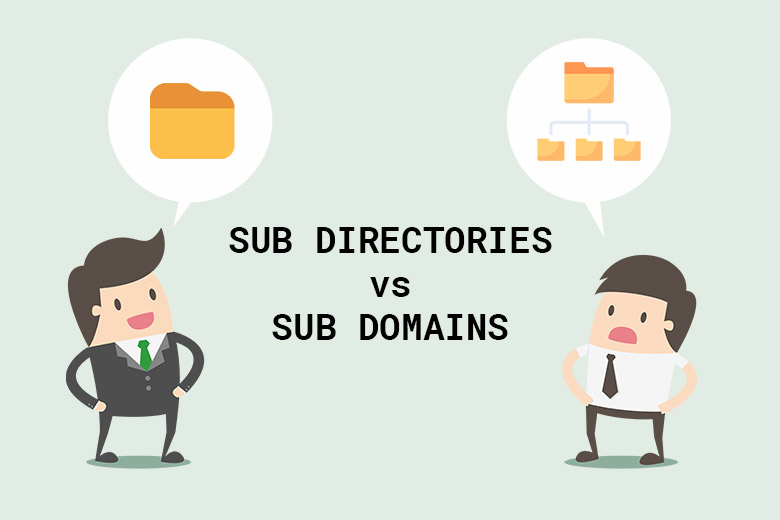
Subdirectories vs Subdomains in 2022
Subdirectories vs subdomains – which are better? This is one of the perennial debates in the SEO community. Our answer? Also a perennial favourite in the industry: it depends.
In this article, we’ll talk about the differences between the subdomains and subdirectories in 2022, their potential impact on SEO, and when it might actually be best to use one or the other. We’ll also make some sense of the contradictory information you have likely heard on the subject.
What is the difference between a subdomain and a subdirectory?
Subdomain and subdirectory URLs have different structures which reflect how the content is organised in relation to the root domain.
If your website domain is www.yourdomain.com,
- A subdomain would look like keyword.yourdomain.com
- A subdirectory would look like www.yourdomain.com/keyword/
Why does this matter for SEO?
Put most simply, Google treats a subdomain as a separate entity. The contents of a subdomain have been partitioned into their own space, separate from the root domain, so may as well be considered a second website. Any SEO that you’ve applied to your root domain and subdomain will be considered separately and will not strengthen each other.
So, if you’ve got valuable blog posts you’ve written on blog.yourdomain.com, they’re not going to benefit the service or product pages on www.yourdomain.com as much as they could. Linking between the two will be a positive signal, but not as beneficial as having internal links on the root domain.
I heard that Google says subdomains and subdirectories are the same. So, why the debate?
This isn’t exactly what Google says. Google says they’re both decent options, but they’ve also admitted that they view the two differently. That’s why this debate keeps cropping up.
Matt Cutts said that the two were of roughly equal value, and that it depends on which one is easier for you, going as far as to say “Whichever one makes you happier, I’d go ahead and do it that way”.
In addition, John Mueller said Google was fine with both, which creates a sense there is basically no difference. However his subdomain or subfolder video, which is often used to claim there is no difference between the two, has been slightly misleading. The end of the video is often ignored. He explains some important differences in this section of the video:
- You need to verify subdomains separately with the Google Search Console.
- Google has to learn how to crawl them separately. (A formality for the most part)
- Settings need to be changed separately.
These considerations are not insignificant. They can be complicated processes that take up a lot of your time, which will add up as you try to own the SEO space.
It’s also important to be sceptical of explanations that essentially draw no distinction between subdomains and subdirectories. Getting SEO advice from Google has been said to be like getting gambling advice from a casino. This is simply to say that while they are the experts on the topic, they aren’t necessarily motivated to share their expertise with you. Once you know the system, it is far easier to game.
Why subdirectories are generally better for SEO
Unless your situation fits into a particular use case, we recommend using subdirectories because:
- It will help you consolidate your domain authority and to maximise your visibility on Google.
- New or peripheral content added will always support your main domain.
- Your main domain content will support new/peripheral content.
When should you use a subdomain?
There are always some exceptions to consider, such as:
- Translations into different languages. In these cases, you’ll likely need separate SEO anyhow.
- Areas with logins. Think forums, support areas, or member-only sections. Password protected items will not be indexed anyway.
The idea of partitioning blog content often comes up around subdomains. Nonetheless, we recommend establishing a content strategy that supports your services and all else that you do. Keep them connected.
Subdomain vs subdirectory case studies
Subdomain vs subdirectory case studies have been excellent for illustrating the effects of shifting between these two strategies. Many were spearheaded by Rand Fishkin, formerly of Moz, who initially shared data from his own experience.
When Moz moved their Beginner’s Guide to SEO away from its guides.moz.com subdomain to the main moz.com directory, rankings rose immediately. Fishkin noted, “We ranked higher not only for “seo guide” (outranking Google themselves) but also for ‘beginners guide’ a very broad phrase.”
Ruth Burr Reedy shared data showing that moving the Saleforce blog from its subdomain to a subdirectory DOUBLED its traffic overnight. Doubled!
Jesse Heap reported a 40% increase in organic traffic to his site nearly overnight after switching to a subdirectory. He mentions that the case study only covered a short window after the change, but said “it is still remarkable how quickly and significantly organic volume and keyword rankings improved after this change.”
In the years since, Fishkin has continued to collect subdomain vs subdirectory case studies showing that in the majority of cases, moving subdomain content to a subdirectory increases traffic.
Unequivocally challenging the claims of Cutts and Mueller that the subdomain vs subdirectory debate really comes down to preference, Fishkin has stated:
“Ultimately, it’s up to you. I understand that Google’s representatives have the authority of working at Google going for them, but I also believe they’re wrong. It could be that there’s no specific element that penalized subdomains and maybe they’re viewed the same in Google’s thinking, but there are real ways in which subdomains inherit authority that stay unique to those subdomains and it IS NOT passed between multiple subdomains evenly or equally. I have no horse in this race other than to want to help you and other site owners from struggling against rankings losses – and we’ve just seen too many when moving to a subdomain and too many gains moving to a subfolder not to be wary.”
In conclusion
Subdirectories are a better option than subdomains in almost every case in 2022. When it comes to using a subdirectory, there are clear benefits with little downside.
On the other hand, there are few benefits to subdomains except in specific cases where you’d likely want a separate SEO program anyway (for another language, for example). Subdomains will require separate SEO, from on-page optimisations to backlinking.
If you’re planning a website restructure, there’s almost no risk in using subdirectories, but you risk a lot of your SEO and site authority by using a subdomain. Why risk it?


